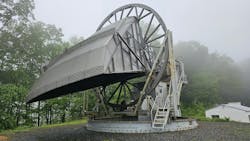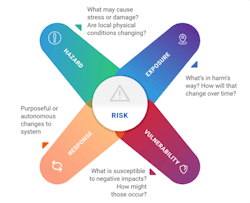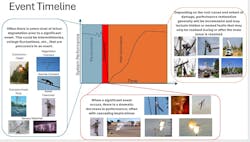From Bell Labs to Smart Grids: Advancing Hazard Detection and Response in Power Systems
Key Highlights
- The discovery of cosmic microwave background radiation at Bell Labs provided key evidence for the Big Bang Theory, showcasing how noise can be transformed into valuable knowledge.
- Modern power grids face increasing hazards from natural and human-induced sources, necessitating advanced detection and response systems to maintain reliability and safety.
- Hazard Awareness Delay (HAD) is a critical metric; reducing it through sensor technology and data analytics enables proactive grid management and faster fault response.
- Emerging technologies like edge sensors and machine learning facilitate early hazard detection, shifting operations from reactive to proactive with Active Grid Response (AGR).
- Just as scientists turned background noise into cosmic insights, utilities now leverage sensor data and AI to uncover hidden hazards, enhancing resilience against climate and operational risks.
A few weeks ago, I had the privilege of visiting the former Bell Labs facility in Crawford Hill in Northeastern New Jersey. This site is known for its massive antenna that was developed in 1964 to trace signals bounced off echo ballons and satellites. Because these radio signals were so weak, eliminating background noise was everything.
Arno Penzias and Robert A. Wilson, the Bell Lab scientists leading this effort, were continually plagued by a strange and persistent buzzing noise that came at all times of the day and night and from all parts of the sky. They persisted in their analysis and, unexpectedly, found this uniform microwave signal suggested residual thermal energy throughout the universe. Most scientists now agree this “background radiation” came from a primordial event: a massive explosion billions of years ago from which our universe originated—the Big Bang. This discovery, known as Cosmic Microwave Background (CMB), provided compelling evidence of The Big Bang Theory.
I had the honor of shaking hands and talking to Dr. Robert A. Wilson, who received the 1978 Nobel Prize in Physics for his work — Demonstrating the power of using a sensitive “ear in the sky” that was able to convert noise into knowledge. The IEEE commemorated this event with their coveted IEEE Milestone Award that honors significant technical achievements in electrical and electronic engineering that have had a lasting impact on humanity.
So, what does this have to do with today’s modern grid?
For decades, engineers have been trying to find ways to gain better insights into things that they cannot see, touch, or feel. As the grid is becoming more sophisticated and interactive, particularly with renewable energy at the edge, the need for timely and accurate data is becoming essential to operate and optimize energy distribution. Further complicating this is the fact that often control engineers must rely on telemetry and other sources of data that may be obscured or buried in the tsunami of streaming bit streams that are flooding system data lakes. The Supervisory Control and Data Acquisition (SCADA) system and Advanced Distribution Management Systems (ADMS) are growing in sophistication and modeling to optimize and prioritize the most important and relevant elements. However, the intelligence required, and results are dependent on being able to accurately model various conditions, which is a challenge as our distribution network becomes more autonomous and automatic.
One of the key focus areas that warrant attention, given the demand for high availability and sustained reliability, is timeliness. Significant effort must be devoted to reducing event-related delays that hurt reliability and resilience, as well as the time required to respond and take corrective action. A new term that is rapidly becoming common parlance in the energy industry is the concept of Hazard Awareness Delay (HAD). HAD is the lag between when a hazard exists on the grid and when operators or systems become aware of it. Reducing this delay is essential for reliability and resilience.
Validation of HAD concept was further described in an Electric Power Research Institute (EPRI) technical report entitled “Climate Resilience and Adaptation Initiative” (Climate READi) that was released in April 2025. This report describes what it calls “vulnerability characterization and timely response.” This technical report offers a structured methodology for electric utilities to assess the vulnerability of power system assets to climate hazards and to develop effective adaptation strategies.
In this report, EPRI introduces the concept of the “risk propeller” (adapted from Simpson et al 2021). This visual helps identify a risk component, namely a hazard, exposure of this hazard, the likelihood of the hazard turning into a risk, and the resulting action or response. These elements ultimately determine the outcome.
Each blade of the propeller covers the following:
- Hazard is often presented as the first component because, without it, there would be no exposure, and any vulnerabilities present in the system would not manifest. Hazard refers to adverse physical conditions that may cause stress or damage. Examples include heat waves, wildfires, and floods.
- Exposure, the second component, is used to express whether the hazard is present at locations of concern (e.g., where assets are located within a system). Examples include substations located in a floodplain or transmission lines in a hurricane-prone area.
- Vulnerability, the third component, determines the likelihood and extent of impacts that may result from exposure to a hazard. Examples might include a flood depth-damage function or threshold-based temperature design ratings.
- Response, the fourth component, refers to purposeful or autonomous (independent) changes to systems or society that can either increase or decrease risk by affecting one of the other components. Purposeful changes include adaptations, whether reactive or proactive, intentionally pursued with the goal of reducing climate-related risk.
While EPRI provides the framework, HAD translates it into practical operations by minimizing the gap between awareness of many existing hazards, trends that lead up to a hazard condition and emerging areas that warrant proper consideration. All of these can influence and direct the appropriate action and response. Essentially, HAD serves as the operational expression of the problem identified in the Climate READi principles—turning early detection into actionable awareness.
What is HAD?
First, let's define hazards. Wikipedia states that a hazard is "the potential occurrence of a natural or human-induced physical event or trend that may cause loss of life, injury, or other health impacts, as well as damage and loss to property, infrastructure, livelihoods, service provision, ecosystems and environmental resources." A hazard only exists if there is a pathway to exposure, like electricity, it holds no power until it finds a way through. It’s the unseen connection that turns potential into consequences.
Our distribution grid is exposed to wide range of hazards, both from nature and humans. Natural hazards include environmental forces such as lightning strikes, high winds, extreme heat and cold, and moisture intrusion. Gradual forces like soil movement and erosion also pose threats, as do wildlife interaction from rodents, birds, squirrels, and encroaching vegetation. Human induced factors include asset tampering, airborne mylar ballons, drones, vehicular accidents, overstressed assets, poor placement, aged or degraded insulators, etc. The resulting impact of these hazards being exposed eventually can lead to risks to life, safety, and reliability.
Events that happen in the grid can be roughly categorized into three phases. Namely, pre-occurrence, occurrence and post-occurrence as shown graphically below.
Traditionally, many grid devices—fault detectors, reclosers, relays—have focused primarily on detecting occurrence events. By contrast, emerging intervention sensor technologies—both physical and electrical—are increasingly capable of identifying pre-occurrence hazards.
Greater awareness of hazards and their potential impacts can provide invaluable insight into how to proactively mitigate risks. For example, identifying where vegetation made contact with conductors can offer an early warning of imminent faults or potential ignition source that may lead to fire.
Although simple in concept, monitoring physical parameters such as conductor, electromagnetic fields, or pole vibration coupled with signature analysis that uses both cross-correlation (matching similar known conditions) and auto-correlation (comparing against normal baseline) can enable machine learning to detect subtle warning signs well in advance of a catastrophic event.
By leveraging the time gap between the early indicators and the actual event, utilities can move from reactive posture to proactive intervention—effectively narrowing the HAD that often governs the speed and success of a fault response. Reducing HAD not only improves situational awareness, but also enables faster, more informed decisions that enhance safety, reliability and resilience.
Beyond prevention, reducing HAD also shortens restoration time and enables a deeper, more immediate understanding of unfolding risks. Imagine a vehicle striking a pole on a quiet stretch of road in rural America. There's no trip, no downed conductor, just a jolt that leaves the structure leaning, a guy wire loosened, and the insulator rattling under tension. To a traditional SCADA system, the grid looks perfectly healthy. But in reality, a pole is hanging in the air, an unflagged vulnerability waiting to fail.
With distributed edge sensors in place, subtle changes in vibration and magnetic field are captured instantly. The system recognizes the event for what it is: a precursor. A crew can be dispatched before the conductor sags further, before the structure fails, before a spark meets dry grass.
This level of awareness enables a new operational model known as Active Grid Response (AGR), a proactive stance built on early signals, edge intelligence, and rapid, informed action. AGR leverages the value of HAD reduction to shift utilities from reactive clean-up to anticipatory care delivering faster restoration, stronger reliability, and a safer grid for everyone it serves.
So how does CMB relate to HAD?
Just as the Bell Labs pioneers were able to turn noise into knowledge about the universe, through creative and non-traditional thinking, so too, the advances and availability of accurate physical, enviornmental, and electrical sensor technology, highly prolific and reliable open standards communication networks, deep signal processing, data analytics, machine learning and intelligence, we can now rely on remote sensors to shorten Hazard Awareness Delay and enable Active Grid Response.
Just as Penzias and Wilson turned meaningless background noise into revolutionary knowledge about the universe, the modern grid can transform “noise” captured from physical, environmental, and electrical sensor data into actionable insights about hidden hazards.
About the Author
Ron Chebra
Vice President of Grid Modernization
Ron Chebra, Executive Director of Chebra Consulting Group [email protected] is a recognized thought leader and industry expert in grid modernization and automation systems. He has a deep operating knowledge in technology solutions in areas such as MicroGrids, Renewable Energy Integration, Smart Grid, Distribution Automation (DA), Advanced Metering Infrastructure (AMI), Energy Management Systems, EV Charging Information Infrastructure and Demand Response. He is a Senior Member of the IEEE; Vice Chair of the NJ Coast Chapter of the PES and Vice Chair of the NJ Coast Chapter IEEE Consultants Network. He is a member of the T&D World Live Advisory Group.



